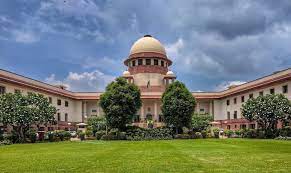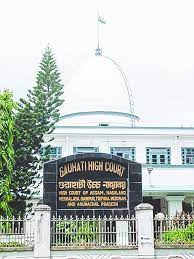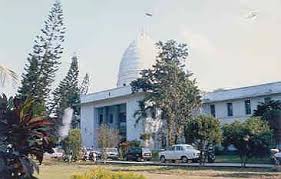This is a defendant’s appeal against the order of the High Court dismissing his second appeal preferred against the judgment and decree of reversal passed by the first appellate Court2 The first appellate Court had not only set aside the decree of the Trial Court3 to the extent it denied complete relief as sought in the suit,4 but decreed the suit of the first respondent in its entirety. (Para 2)
The plaint case was that, — (a) the land in dispute admeasuring 3 bighas was jointly purchased by the plaintiff and defendant nos.2 to 48 vide two separate sale-deeds dated 02.03.1970 and 16.03.1970; (b) out of the total area of the disputed land, 1 bigha, comprising a portion of plot no.294/83, was converted to non-agricultural use for setting up a Petrol Pump and, for that purpose, the District Collector issued NOC9 on 23.07.1971; (c) the Trust had not acquired the land by any lawful manner, yet, it started showing itself as owner in possession of the disputed land, as a result, when, on 23.4.1997, the Trust threatened to acquire the land, the suit had to be instituted. Additionally, it was pleaded that neither the provisions of the 1894 Act10 nor of the 1959 Act11 were followed to acquire the land as neither opportunity of hearing nor compensation was provided to either the plaintiff or defendant nos. 2 to 4. Appellant’s case in the Written Statement (Para 5)
The trial court thus concluded that plaintiff did not approach the Court with clean hands. Consequently, the suit was decreed only to the extent of that 1 bigha of the disputed land regarding which, the appellant had given up its claim. (Para 9)
No appeal was preferred by the Trust. Consequently, the decree of the trial court to the extent of 1 bigha of the disputed land became final as against the Trust. (Para 10)
In these circumstances, non-mutation of plaintiff’s name in the revenue records would not defeat plaintiff’s claim that acquisition notification was bad for non-service of notice on him. With these observations, and finding upon that possession of the land was taken on 10.6.1998, the first appellate court decreed plaintiff’s suit in its entirety. (Para 12)
The High Court opined that purchase of land by the plaintiff in the year 1970, prior to the acquisition was not disputed; the acquisition notification was issued without serving notice on the plaintiff, therefore, the acquisition was void and suit as instituted was maintainable. Moreover, the plaintiff was in possession up to the date of institution of the suit. It thus upheld the decree of the first appellate court and dismissed the second appeal. (Para 15)
Though the aforesaid issues are interrelated but, for clarity, I propose to deal with them separately. Issue No.(i) — Whether the notification under Section 52(1) of the 1959 Act could have been treated as void by the Civil Court? (Para 24)
The question which falls for consideration is, whether for want of service of notice of proposed acquisition under sub-section (2) of Section 52 of the 1959 Act, the acquisition notification, under section 52 (1) of the 1959 Act, could be treated as void and, therefore, vulnerable to a collateral attack. (Para 25)
In the light of aforesaid legal principle, the argument on behalf of the plaintiff-respondent is that, as notice contemplated under sub-section (2) of Section 52 of the 1959 Act was not given to the owner of the land prior to the acquisition notification, the notification would be void and, therefore, the Civil Court would have jurisdiction to grant appropriate relief by treating the same as void notwithstanding that there is no specific challenge to it. (Para 42)
In the instant case, the plaintiff’s case is not that his name was mutated in the record of rights, rather his case is that the district administration was aware of his title to the land because they had issued NOC for conversion of that agricultural land to nonagricultural land. (Para 49)
In my view, the suit in question is a classic example of clever drafting where to avoid crucial issues, such as the bar of limitation and response from the State, firstly, no declaration in respect of the acquisition notification was sought and, secondly, the State, which issued the acquisition notification and in whom the title of the land vested by a deeming fiction, was not impleaded as a party. Such clever drafting to avoid critical issues have been deprecated time and again by this Court as it amounts to an unfair practice. (Para 61)
As I have found the suit not maintainable insofar as it related to the land covered by the acquisition notification and also barred by Section 207 read with Section 256 of the Rajasthan Tenancy Act, 1955, the defendant’s appeal is entitled to be allowed and is hereby allowed. The judgment and decree of the High Court as well as of the First Appellate Court are set aside and the decree passed by the Trial Court is restored. (Para 74)
The upshot of the above is that the appellant here failed to establish that they had acquired the land in accordance with the law or paid due compensation to the affected party. The appellant took forceful possession of the respondents’ valuable land by disregarding the legal process and thereby denied the protection of procedural fairness to the respondents. (Para 113)
SUPREME COURT OF INDIA
2023 STPL(Web) 361 SC
[2023 INSC 935]
Urban Improvement Trust, Bikaner Vs. Gordhan Dass (D) Through Lrs. & Others
Civil Appeal No. 8411 of 2014-Decided on 19-10-2023
https://stpllaw.in/wp-content/uploads/2023/10/2023-STPLWeb-361-SC.pdf







